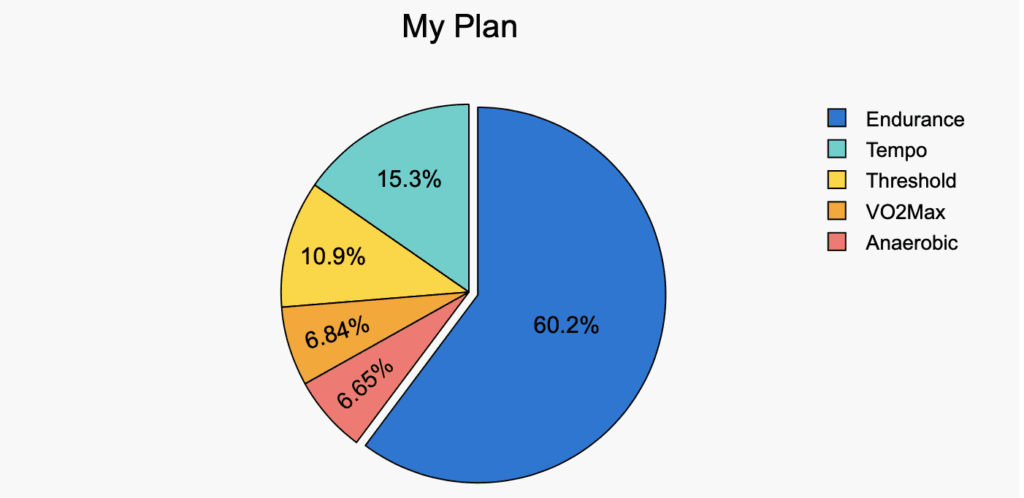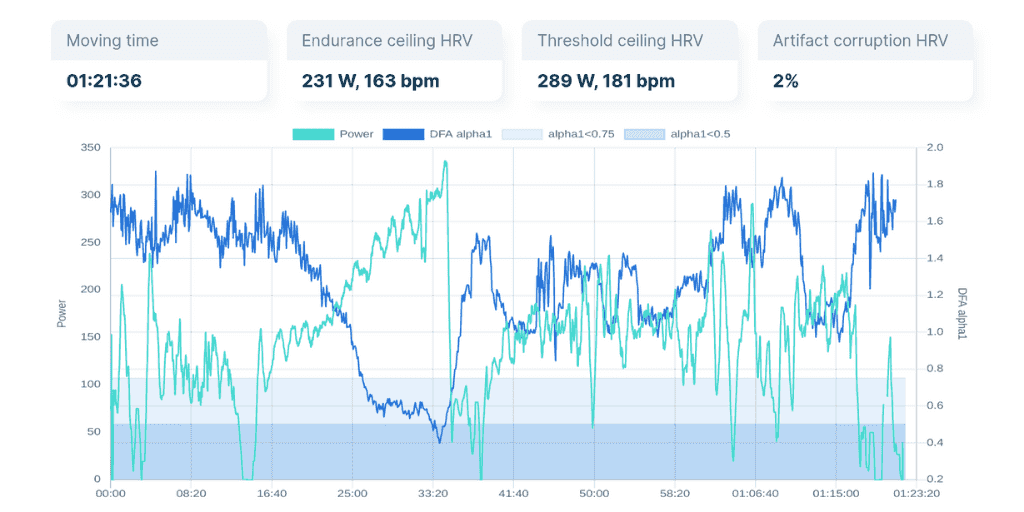
In this post, we give a short introduction to the running training zones and cycling training zones we use to structure your training. We use 5 training zones defined by pace for running activities and by power for cycling activities. AI Endurance calculates these zones for you individually based on your past training data.
For running, the workout instructions and pace zones given by AI Endurance are always in Gradient Averaged Pace (GAP). GAP takes into account the elevation gains and losses during your run and normalizes your running pace to an equivalent pace on a flat course. If the course is flat GAP equals raw pace. If you are running uphill or downhill you need to adjust your pace for the given gradient. For example, if you're running up a steep hill you need to slow your raw pace so your effort is the same as it was on the flat.
This is the pace/power you can theoretically hold indefinitely and most athletes should spend the majority of their training in this zone.

Perceived exertion is easy, you’re not breathing hard and you should have no problem holding a conversation. There are many benefits of training in this zone including increased aerobic base and endurance and short recovery periods after workouts.
For cycling, we define Endurance as less than 75% of your FTP. For running, less than 75% of your 5k pace and less than 80% of your 10k pace.
This is the ‘somewhat hard’ or ‘comfortably hard’ zone. It should be a bit harder to hold a conversation but still possible to do so. You should be able to maintain the pace/power for more than an hour in a race. Benefits include enhanced endurance and increased speed and efficiency for running.
For cycling, we define Tempo as 75-90% of FTP. For running, 75-85% of your 5k pace and 80-90% of your 10k pace.
Threshold is defined as your maximal aerobic intensity. At this intensity your blood lactate concentration still remains stable, but even a slightly higher intensity leads to increased accumulation of lactate - you are at the lactate threshold (LT). If lactate accumulates, you will eventually need to slow down since it will hamper your output. Since this zone is very specific, it is difficult to pinpoint (except under laboratory conditions) so think of the zone as a small range around this point. Your cycling power at LT is defined to be your functional threshold power (FTP). This intensity certainly feels hard, and it is hard to focus on keeping a conversation going. However, you should still be able to hold this intensity for long durations of up to an hour. It definitely shouldn’t feel like you have to stop after a few minutes. Training in this zone is very beneficial for your aerobic system but also requires a decent amount of recovery as it is hard on you.
For cycling, we define the Threshold zone as 90-106% of FTP. For running, 85-95% of your 5k pace and 90-100% of your 10k pace.
V02Max is the maximum volume of Oxygen (O2) your body can absorb - it is your maximal aerobic capacity. In this zone, you are working at maximum oxygen uptake significantly above LT, so lactate is rapidly accumulating (it hurts). Your breathing is very hard and a conversation is pretty much impossible. Intervals in the VO2Max Zone are a few minutes in duration and are generally hugely beneficial for your cardiovascular fitness but also require significant recovery.
For cycling, we define VO2Max as 106-120% of FTP. For running, 95-100% of your 5k pace and 100-105% of your 10k pace.
The Anaerobic Zone is where you almost entirely rely on the anaerobic (absence of oxygen) energy stores in your muscle cells. The intensity is so high that aerobic contribution to your output is small and since your anaerobic energy stores deplete quickly you have to stop after a short time. Intervals are typically between a few seconds (sprint) up to a minute in duration. Anaerobic workouts develop your anaerobic capacity (lactate tolerance), work your fast twitch fibers and are generally beneficial to your form and efficiency.
For cycling, we define Anaerobic as greater than 120% of FTP. For running, greater than 100% of your 5k pace and greater than 105% of your 10k pace.
We propose a fitness test every 4 weeks in our training plans. This allows the AI algorithm to properly track your current performance level. We recommend to update your FTP, 5k and 10k pace after every test. Your performance level changes rather slowly: on a scale of weeks rather than days. If you have trained according to the plan and didn't do the test you can also adjust your performance level according to the predictions plotted in the dashboard.
As commonly used, we define FTP as 95% of your best 20 minute power. For a ramp test, we calculate your FTP as 75% of your best 1 minute power.
We define 5k pace as your best 15 minute GAP and 10k pace as your best 30 minute GAP. So technically by 5k pace we are referring to a mostly VO2Max pace, while 10k pace is more of a Threshold pace and they are not really tied to the distances 5k and 10k. Defining these paces via time and not via distance has proven more useful for our algorithm for the following reasons: a) taking gradient into account makes distance a difficult to use standard (a 5k very hilly run takes longer than a flat 5k for the same effort). b) slower athletes will work in lower intensity zones for the same distance than faster athletes.
Other zone systems sometimes split the Endurance Zone into ‘Active Recovery’ and ‘Endurance’ to define activities that are purely for recovery purposes. Also the Anaerobic zone is sometimes split into ‘Anaerobic’, i.e. intervals of about a minute and ‘Neuromuscular’, i.e. sprinting intervals. We feel however that the 5 Zone system captures the most important aspects of our training plans.
Thanks for reading!

Before every workout you should know if you're actually ready for it. Everyone responds differently to stress, bad sleep and exercise fatigue - our new recovery model makes data driven decisions about when you should train and when you shouldn't - based on heart rate variability (HRV).

Apple Watch has been a popular choice in running and triathlon. You can now track and execute your AI Endurance custom running, cycling and swimming workouts on your Apple Watch.

Power meters are costly and we often can't afford one on every bike we own. AI Endurance calculates cycling power from activities without a power meter using heart rate, cadence and DFA alpha 1. The results are generally more accurate than speed based estimates such as Strava's estimated power. All you need is a heart rate monitor and ideally a cadence sensor on your bike and AI Endurance will estimate your power for every ride.

DFA alpha 1 is a heart rate variability (HRV) metric that allows tracking of the aerobic and anaerobic threshold. We explain the breakthrough potential of this new metric and how you can track your DFA alpha 1 thresholds with the AI Endurance app, Garmin and Zwift.